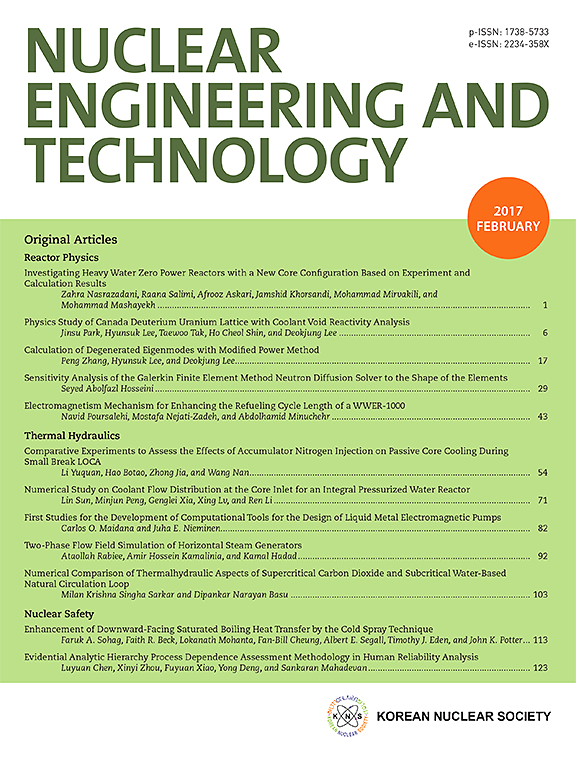Effect of brazing parameters on the microstructure and mechanical properties of SiC ceramic joint with Zr-Cu-Nb filler metal
IF 2.6
3区 工程技术
Q1 NUCLEAR SCIENCE & TECHNOLOGY
引用次数: 0
Abstract
The excellent properties of SiC ceramic make them possible to replace zirconium alloy and become the 4th generation of nuclear power plant cladding material. In this study, the microstructure and mechanical properties of SiC ceramic joint with Zr-Cu-Nb powder filler metal under different brazing temperature and holding time were investigated. The results show that Zr-Cu-Nb filler metal can effectively braze SiC ceramic at different brazing temperature (9501150 °C) with the holding time of 20 min. The primary phases in the interface reaction layer are mainly ZrC and Zr2Si. The shear strength of the joint first increases and then decreases with the brazing temperature, reaching a maximum of 135 MPa at 1050 °C under the holding time of 20 min. The joint primarily fractures at the reaction layer, exhibiting brittle fracture behavior. The thickness of the interface reaction layer increases with the holding time(560min) under the brazing temperature of 1050 °C. The shear strength of the joint reaches its maximum of 135 MPa at 20 min under the brazing temperature of 1050 °C, with the thickness of the reaction layer being 1.2 m. The joint primarily fractures at the reaction layer, exhibiting brittle fracture behavior.
钎焊参数对Zr-Cu-Nb钎料SiC陶瓷接头显微组织和力学性能的影响
SiC陶瓷的优异性能使其有可能取代锆合金,成为第四代核电站包层材料。研究了Zr-Cu-Nb粉末钎料SiC陶瓷接头在不同钎焊温度和保温时间下的显微组织和力学性能。结果表明:Zr-Cu-Nb钎料在不同钎焊温度(950 ~ 1150℃)下均能有效钎焊SiC陶瓷,保温时间为20 min,界面反应层中主要相为ZrC和Zr2Si;随着钎焊温度的升高,接头的抗剪强度先增大后减小,在1050℃保温20 min时,接头抗剪强度最大达到135 MPa。接头主要在反应层断裂,表现为脆性断裂行为。在1050℃的钎焊温度下,界面反应层厚度随保温时间(5 ~ 60min)的增加而增加。当钎焊温度为1050℃,反应层厚度为1.2 μm时,焊接头抗剪强度在20 min时达到最大,达到135 MPa。接头主要在反应层断裂,表现为脆性断裂行为。
本文章由计算机程序翻译,如有差异,请以英文原文为准。
求助全文
约1分钟内获得全文
求助全文
来源期刊

Nuclear Engineering and Technology
工程技术-核科学技术
CiteScore
4.80
自引率
7.40%
发文量
431
审稿时长
3.5 months
期刊介绍:
Nuclear Engineering and Technology (NET), an international journal of the Korean Nuclear Society (KNS), publishes peer-reviewed papers on original research, ideas and developments in all areas of the field of nuclear science and technology. NET bimonthly publishes original articles, reviews, and technical notes. The journal is listed in the Science Citation Index Expanded (SCIE) of Thomson Reuters.
NET covers all fields for peaceful utilization of nuclear energy and radiation as follows:
1) Reactor Physics
2) Thermal Hydraulics
3) Nuclear Safety
4) Nuclear I&C
5) Nuclear Physics, Fusion, and Laser Technology
6) Nuclear Fuel Cycle and Radioactive Waste Management
7) Nuclear Fuel and Reactor Materials
8) Radiation Application
9) Radiation Protection
10) Nuclear Structural Analysis and Plant Management & Maintenance
11) Nuclear Policy, Economics, and Human Resource Development
 求助内容:
求助内容: 应助结果提醒方式:
应助结果提醒方式:


